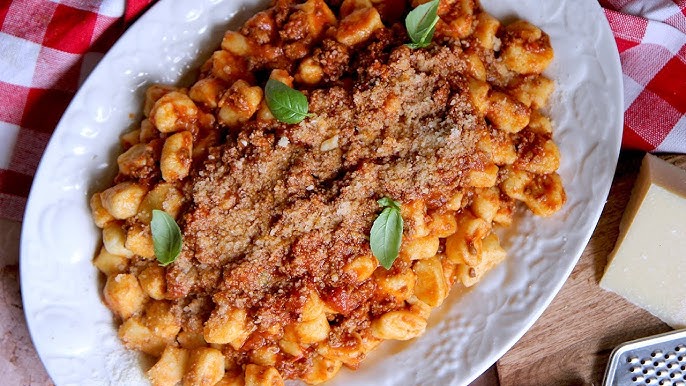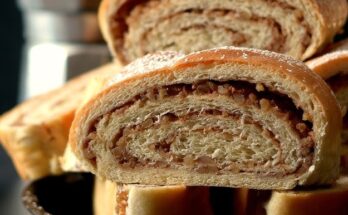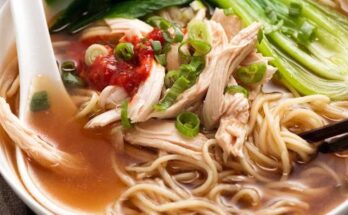Ricotta Gnocchi Recipe: Ricotta gnocchi is the softer, silkier cousin of the traditional potato gnocchi. Instead of boiled and mashed potatoes, this version uses creamy ricotta cheese as its base, which gives it a lighter texture and a delicate flavor that’s hard to resist. Think of it as pillows of cheesy joy—easy to make, incredibly comforting, and super versatile. Whether you’re looking for a quick weeknight dinner or an elegant dish to impress guests, ricotta gnocchi fits the bill perfectly.
Unlike store-bought gnocchi that can often be rubbery or dense, homemade ricotta gnocchi melts in your mouth. It’s a staple in many Italian households, but the good news is—you don’t have to be a professional chef to pull it off. If you can mix ingredients in a bowl and boil water, you can make ricotta gnocchi from scratch.
The process involves combining ricotta with eggs, flour, and cheese, forming a dough, shaping it into soft dumplings, and boiling them for just a couple of minutes. It’s that simple. But like any great Italian recipe, the magic is in the details, and we’ll guide you through every step.
Why You’ll Love This Homemade Recipe
Why do foodies and home cooks swear by this ricotta gnocchi recipe? Because it hits all the marks: quick to prepare, rich in flavor, and easy on the stomach. Here are some of the reasons you’ll fall in love with it:
- Time-Saving: Traditional potato gnocchi requires boiling, peeling, and mashing potatoes—not to mention cooling time. Ricotta gnocchi skips all that. You can have it on the table in under 45 minutes.
- Fewer Ingredients: With just a handful of pantry staples, you can whip up an authentic Italian dish that tastes like it’s straight from a trattoria.
- Versatile: Dress it up or down—pair it with a simple butter sauce or something robust like a ragu or pesto.
- Family-Friendly: Even picky eaters tend to devour ricotta gnocchi. Plus, it’s a great way to get kids involved in the kitchen.
- Elegant Yet Simple: Whether it’s date night or a family gathering, ricotta gnocchi adds a gourmet touch without the stress.
If you’ve never made homemade gnocchi before, don’t worry. This guide will walk you through everything step-by-step, with tips and tricks to make your experience smooth and fun.
List of Ingredients You’ll Need
Main Ingredients for the Gnocchi Dough
Making ricotta gnocchi at home doesn’t require any fancy or hard-to-find ingredients. Most of these are probably already in your kitchen:
- Ricotta Cheese (1 cup) – The star of the show. Go for whole milk ricotta for the creamiest texture.
- All-Purpose Flour (3/4 to 1 cup) – Start with 3/4 cup and add more only if needed. Too much flour can make the gnocchi heavy.
- Egg (1 large) – Helps bind the dough and adds richness.
- Grated Parmesan Cheese (1/2 cup) – Adds a salty, nutty kick. Use freshly grated Parmigiano Reggiano if possible.
- Salt (1/2 tsp) – Enhances the overall flavor.
- Black Pepper (a pinch) – Optional, but a little pepper adds depth.
- Nutmeg (a pinch) – Traditional in many Italian recipes; complements the cheese beautifully.
That’s it. These simple ingredients come together to create something greater than the sum of their parts.
Optional Add-ins for Extra Flavor
Want to level up your gnocchi game? Try these optional add-ins:
- Fresh Herbs (e.g., basil, thyme, parsley) – Finely chopped for a fragrant touch.
- Lemon Zest – A little zest adds brightness and makes the dish pop.
- Ricotta Salata – For an extra layer of cheesy goodness.
- Garlic Powder or Roasted Garlic – If you’re a garlic lover, a hint of it in the dough is divine.
Best Sauces to Pair with Ricotta Gnocchi
Ricotta gnocchi is incredibly versatile when it comes to sauces. It’s mild and creamy, making it a perfect canvas for a wide variety of flavors:
- Brown Butter and Sage – Classic and heavenly.
- Tomato Basil Sauce – Light and fresh, ideal for summer meals.
- Pesto Sauce – Basil or sun-dried tomato pesto complements the gnocchi well.
- Creamy Alfredo or Gorgonzola Sauce – For a richer, more indulgent meal.
- Mushroom Cream Sauce – Earthy and comforting, great for cooler months.
The best part? You can make big batches of gnocchi and freeze them—just cook them fresh when you’re ready and pair with your favorite sauce.
Kitchen Tools You’ll Need
Essential Equipment for Gnocchi Making
You don’t need a pasta machine or any specialized gadgets to make ricotta gnocchi, which is another reason it’s such a beloved recipe. Here’s what you’ll want to have ready:
- Mixing Bowl – For combining all your ingredients.
- Fork or Wooden Spoon – To mix everything gently.
- Measuring Cups and Spoons – Precision matters here.
- Large Pot – For boiling water to cook your gnocchi.
- Slotted Spoon – Makes it easy to lift the gnocchi out of the water.
- Colander – If your ricotta needs draining.
Handy Extras for a Smoother Experience
If you have these, they’ll make the process even easier:
- Gnocchi Board or Fork – To give your gnocchi those signature ridges (totally optional).
- Parchment Paper – For lining your tray before boiling.
- Bench Scraper – Handy for cutting and shaping the dough cleanly.
You don’t need to go out and buy anything fancy. Most of what you need is probably already in your kitchen.
How to Choose the Right Ricotta Cheese
Fresh vs. Store-Bought Ricotta
This is one of the most important choices you’ll make in this recipe. Not all ricotta is created equal. Ideally, you want a firm, creamy ricotta with minimal moisture. Here’s a quick comparison:
- Fresh Ricotta (from a deli or Italian market) – Light, fluffy, and less watery. Perfect texture for gnocchi.
- Store-Bought Ricotta (from a tub) – Often more watery and grainy. Still usable, but you’ll need to drain it thoroughly.
If you’re feeling adventurous, making your own ricotta at home with milk, cream, and lemon juice is surprisingly easy—and tastes amazing.
Tips for Draining Ricotta Properly
Watery ricotta is the most common cause of sticky, unworkable gnocchi dough. Here’s how to avoid that:
- Use Cheesecloth or Paper Towels – Line a colander and place it over a bowl. Dump the ricotta in and let it sit for 30–60 minutes.
- Gently Press Out Moisture – Don’t squeeze too hard, just let gravity do the work.
- Refrigerate While Draining – This keeps the cheese fresh and safe.
Your ricotta should be thick and spreadable, almost like cream cheese. Once it reaches that texture, you’re ready to roll—literally!
Step-by-Step Guide to Making Ricotta Gnocchi
Step 1: Prepare the Ricotta
Before you dive into making the dough, prepping the ricotta correctly is essential. Moisture is the enemy of light, fluffy gnocchi, so the first step is to drain your ricotta properly. Even if it looks thick in the container, don’t skip this step.
To start, line a colander with cheesecloth or clean paper towels. Spoon the ricotta into the cloth and let it sit over a bowl or sink for 30 minutes to an hour. If you’re pressed for time, you can lightly press the ricotta with a spoon to encourage the liquid to release faster. You’ll be surprised how much water comes out even from store-bought “dry” ricotta.
Once drained, transfer the ricotta to a bowl and give it a quick stir. The texture should be creamy, not watery. If it’s too wet, your gnocchi will require more flour, which will weigh them down and make them doughy instead of pillowy. Once the ricotta is prepped, you’re ready for the next step: dough mixing.
Step 2: Mix the Dough
In a large mixing bowl, combine your drained ricotta, egg, grated Parmesan, a pinch of salt, and a dusting of nutmeg (if you like). Use a fork or wooden spoon to gently mix everything together.
Now, sprinkle in about ¾ cup of flour. Fold it into the mixture gently—don’t overmix. The key to perfect gnocchi is keeping the dough soft and light, so only add as much flour as needed to form a workable dough. If it’s too sticky, you can add a little more flour, a tablespoon at a time.
Once your dough comes together, transfer it to a lightly floured surface and knead it a few times to form a soft, smooth ball. Don’t overwork it—you’re not making bread. Just bring it together enough so it’s no longer sticky and holds its shape.
Divide the dough into four pieces. You’ll use each piece to roll and cut your gnocchi.
Step 3: Shape the Gnocchi
On a lightly floured surface, take one portion of the dough and roll it into a long rope about ½ inch thick. Don’t rush—use your palms and roll gently to keep the rope even.
Once rolled out, use a sharp knife or bench scraper to cut the rope into 1-inch pieces. These are your gnocchi! If you want to get fancy, you can roll each piece over a gnocchi board or the back of a fork to create ridges. These ridges help hold onto sauces better, but it’s purely optional. Smooth gnocchi taste just as amazing.
Repeat with the remaining dough pieces. As you work, place your gnocchi on a parchment-lined tray dusted with flour to prevent sticking. Try not to stack them—single layers are best.
Let the shaped gnocchi rest for about 15–20 minutes before cooking. This allows them to firm up slightly and helps them hold their shape in boiling water.
Step 4: Cook the Gnocchi
Bring a large pot of salted water to a boil—just like pasta water. Gently add the gnocchi to the pot, about 10–15 pieces at a time to avoid overcrowding.
Here’s the magic part: gnocchi tells you when it’s done. As soon as they float to the top, they’re ready. This usually takes just 2–3 minutes. Don’t overcook them or they’ll become mushy.
Use a slotted spoon to gently scoop out the gnocchi and transfer them to a warm plate or pan. If you’re cooking in batches, keep them warm in a low oven while you finish the rest.
At this point, you can either toss them with your sauce of choice immediately or give them a quick sauté in butter for a golden finish. If pan-searing, just heat a tablespoon of butter in a nonstick skillet and cook the gnocchi for a couple of minutes until golden on each side.
Step 5: Serve and Enjoy
Now comes the fun part—serving and devouring your homemade ricotta gnocchi! Spoon your favorite sauce over the gnocchi and garnish with extra Parmesan, cracked black pepper, or fresh herbs.
Here are a few serving ideas to inspire you:
- Simple & Elegant: Toss with brown butter, fried sage leaves, and a sprinkle of sea salt.
- Comfort Food Classic: Serve with marinara and gooey mozzarella, then bake for a few minutes.
- Fresh & Light: Toss with pesto and cherry tomatoes.
- Creamy & Decadent: Mix with Alfredo sauce, crispy pancetta, and peas.
Serve with a side salad or roasted vegetables and a glass of chilled white wine or red blend. You’ve just made a gourmet Italian meal right in your kitchen—enjoy every bite.
Common Mistakes to Avoid
Overworking the Dough
This is probably the number one mistake when making any kind of gnocchi. Unlike bread or pizza dough, which needs kneading to develop gluten, gnocchi dough should be handled as little as possible. The more you knead and mix, the denser your gnocchi will become. Think of it like mixing muffin batter—stop as soon as everything comes together.
The goal is a soft, supple dough that holds together but still feels light. If your gnocchi turns out rubbery or tough, chances are you’ve overmixed it. Be gentle and use a light hand.
Here are some tips:
- Use a fork or wooden spoon instead of a stand mixer.
- Fold the ingredients rather than vigorously stirring.
- Don’t press or knead like you would with bread dough.
Let your dough rest for 5–10 minutes before shaping. It gives the flour time to hydrate and makes the dough easier to work with.
Using Too Much Flour
Flour is essential to bind the ricotta and hold the gnocchi together, but too much of it can quickly turn your soft dumplings into chewy bricks.
Ricotta varies in moisture content, so always start with the minimum amount of flour (¾ cup) and add more only if necessary. The dough should feel soft, moist, and slightly tacky—not dry or stiff.
Some signs you’ve added too much flour:
- Dough is crumbly and hard to roll.
- Gnocchi feel heavy or dense after cooking.
- You need to press hard to shape the dough.
Less is more here. The lighter your dough, the softer and more delicate your gnocchi will be.
Expert Tips for Perfect Ricotta Gnocchi
Keep the Dough Light and Fluffy
Making gnocchi is all about feel. If there’s one rule to remember: treat the dough like a delicate baby bird—gently, with care, and never forcefully. The lighter your touch, the fluffier your gnocchi will turn out.
- Tip 1: Less Flour, More Flavor – Add just enough flour to bring the dough together. Over-flouring results in dense gnocchi.
- Tip 2: Use a Bench Scraper – This tool makes it easy to cut dough cleanly without tearing.
- Tip 3: Dust Lightly with Flour While Rolling – Don’t go overboard. Just enough to prevent sticking.
Don’t stress about perfect shapes. Rustic gnocchi are just as beautiful—and tastier because you made them with love.
How to Freeze Gnocchi for Later
Want to make a big batch? Gnocchi freezes like a dream. Here’s how to store them properly:
- Lay Uncooked Gnocchi on a Baking Sheet – Arrange them in a single layer so they don’t stick together.
- Freeze Until Solid (1–2 Hours) – Once frozen, they won’t clump.
- Transfer to a Freezer Bag or Container – Label with the date and keep for up to 2 months.
To cook, no need to thaw—just drop frozen gnocchi into boiling salted water. They’ll take a minute longer to cook but will float to the top just the same. Perfect for meal prep or unexpected guests!
Ricotta Gnocchi vs Potato Gnocchi
Texture Differences
You might be wondering: “What’s the big difference between ricotta gnocchi and potato gnocchi?” It’s a great question, especially if you’ve tried one and not the other.
- Ricotta Gnocchi is lighter, softer, and has a creamier texture. It’s almost like a soft dumpling that melts in your mouth.
- Potato Gnocchi, on the other hand, is chewier and denser due to the starch in the potatoes. It has a more “doughy” feel.
The ricotta version tends to absorb sauces more quickly and doesn’t hold its shape as firmly as potato gnocchi—but in return, you get a dish that feels more elegant and less heavy.
Flavor Profiles
When it comes to flavor:
- Ricotta Gnocchi has a subtle cheese flavor that works beautifully with simple sauces like brown butter or sage.
- Potato Gnocchi has a neutral base, allowing stronger sauces like meat ragù to shine.
Ultimately, it comes down to preference and mood. Want something light and pillowy? Go ricotta. Craving hearty Italian comfort food? Potato gnocchi might be your match.
Delicious Sauce Pairing Ideas
Brown Butter and Sage
This is a match made in culinary heaven. The nuttiness of brown butter combined with earthy sage leaves perfectly complements the creaminess of ricotta gnocchi.
How to Make It:
- Melt butter (about 4 tablespoons) in a skillet over medium heat.
- Add a handful of fresh sage leaves.
- Cook until the butter turns golden and starts to smell nutty.
- Toss cooked gnocchi directly in the pan and sauté for 1–2 minutes.
Finish with grated Parmesan and a pinch of sea salt. Simple. Stunning. Sublime.
Tomato Basil Sauce
Perfect for when you want a classic, crowd-pleasing sauce that’s fresh and vibrant.
Ingredients:
- Crushed San Marzano tomatoes
- Olive oil
- Garlic
- Fresh basil
Simmer everything for 20–25 minutes, then toss your gnocchi in and top with mozzarella pearls or Parmesan. Great with a garden salad and some crusty bread.
Creamy Alfredo Twist
Want indulgence? This is it.
Quick Alfredo Sauce:
- 1 cup heavy cream
- 1/2 cup grated Parmesan
- 2 tablespoons butter
- Salt and pepper to taste
Heat everything gently in a pan until smooth. Add gnocchi and stir to coat. For a fun twist, toss in spinach or peas and top with crispy pancetta.
Gluten-Free and Vegan Ricotta Gnocchi Variations
How to Make Gluten-Free Ricotta Gnocchi
No gluten? No problem. Ricotta gnocchi is very adaptable.
Substitute All-Purpose Flour with:
- Gluten-Free 1:1 Baking Flour (like Bob’s Red Mill or King Arthur)
- Almond Flour (for low-carb variation, though it’s more delicate)
- Chickpea Flour (for a nutty flavor)
The process is exactly the same—just be gentle when handling the dough, as gluten-free flours are often more fragile.
Tip: Chill the dough for 15–20 minutes before rolling to make it easier to work with.
Vegan Substitutes That Work Well
Want to skip the dairy and eggs? You can still enjoy fluffy gnocchi:
- Ricotta Swap: Use vegan ricotta made from almonds, tofu, or cashews.
- Egg Substitute: 1 tablespoon ground flaxseed mixed with 3 tablespoons water works well as a binder.
Stick to the same proportions and test the dough by rolling a small amount first. If it holds its shape and cooks well, you’re good to go!
Storage and Reheating Tips
How to Store Leftover Gnocchi
If you find yourself with leftovers (lucky you), here’s how to keep them fresh:
- In the Fridge: Place in an airtight container. Add a drizzle of olive oil to keep them from sticking together. Good for up to 3 days.
- In the Freezer: If already cooked, spread on a tray and freeze individually before transferring to a container. Best used within 2 months.
Avoid refrigerating uncooked gnocchi for long—they’ll absorb moisture and become soggy.
Best Way to Reheat Without Losing Texture
There’s a right and wrong way to reheat gnocchi. Here are your options:
- Sauté in a Pan: Add a little butter or olive oil and heat over medium heat until warmed through. Best for crispy edges!
- Microwave: Use a microwave-safe bowl and add a splash of water or sauce. Cover and heat in 30-second bursts.
- Oven Bake: If your gnocchi is already sauced, cover with foil and bake at 350°F (175°C) for 15–20 minutes.
Avoid boiling again—your beautiful gnocchi will fall apart!
Serving Suggestions and Side Dishes
What to Serve with Ricotta Gnocchi
Ricotta gnocchi may be the star of the show, but the right side dishes can elevate your meal to restaurant-quality status. Because gnocchi is creamy and soft, you’ll want to pair it with sides that add texture or contrast in flavor.
Here are a few favorites:
- Crisp Green Salad: A lightly dressed arugula or mixed greens salad balances the richness of the gnocchi. Add shaved Parmesan and toasted walnuts for a gourmet touch.
- Roasted Vegetables: Oven-roasted broccoli, Brussels sprouts, or asparagus add earthiness and crunch. Toss them in olive oil, garlic, and sea salt before roasting.
- Garlic Bread or Focaccia: Crusty bread is perfect for soaking up any extra sauce. Try a rosemary focaccia or a garlic knot for something fun.
- Grilled Chicken or Fish: A protein like lemon-herb chicken breast or baked salmon rounds out the meal without overpowering the gnocchi.
- Soup Starter: Begin with a small serving of soup—like tomato basil or minestrone—to warm the palate.
Think balance. Since gnocchi is soft and mild, pair it with something fresh, crunchy, or bold to make the whole meal shine.
Wine Pairing Ideas
Gnocchi and wine? Absolutely.
Here are some pairing suggestions based on the sauce you choose:
- Brown Butter and Sage Gnocchi: Go for a Chardonnay—buttery and smooth, it mirrors the sauce beautifully.
- Tomato-Based Sauces: A Chianti or Sangiovese brings acidity that cuts through the richness.
- Creamy Alfredo Sauce: A crisp Pinot Grigio or Gavi balances the creaminess without being too heavy.
- Pesto or Herb-Based Sauces: Try a Vermentino or Sauvignon Blanc—both are light and herbaceous.
If you prefer red wine, stick with medium-bodied options and avoid overly tannic varieties. You want the wine to complement, not dominate.
FAQs about Ricotta Gnocchi Recipe
Can I make ricotta gnocchi ahead of time?
Yes! You can shape the gnocchi, place them on a floured tray in a single layer, and refrigerate them for up to 1 day before cooking. For longer storage, freeze them uncooked on a tray, then transfer to a bag or container for up to 2 months.
Why is my gnocchi dough too sticky?
It’s likely your ricotta wasn’t drained well enough. Next time, make sure to strain the ricotta in a cheesecloth-lined colander for at least 30–60 minutes before mixing. If the dough is already sticky, add a bit more flour—one tablespoon at a time—until it’s workable.
How do I know when gnocchi is done cooking?
Gnocchi float to the surface of the boiling water when they’re ready. Once they rise, let them cook for 30 seconds longer, then remove with a slotted spoon. Overcooking can make them mushy.
Can I freeze uncooked ricotta gnocchi?
Absolutely. Place shaped gnocchi in a single layer on a baking sheet and freeze until solid. Then transfer to an airtight bag or container. Cook directly from frozen—no need to thaw!
What’s the best sauce for ricotta gnocchi?
That depends on your taste! Brown butter with sage is a classic, while tomato basil and pesto are fresh and flavorful. For something rich, try Alfredo or a gorgonzola cream sauce. Ricotta gnocchi pairs well with nearly anything.
Conclusion
There you have it—everything you need to know about making authentic, fluffy, and melt-in-your-mouth ricotta gnocchi from scratch. Whether you’re cooking for a weeknight dinner or a special occasion, this dish never disappoints.
From choosing the right ricotta and using just the right amount of flour, to shaping the gnocchi with love and pairing it with your favorite sauce—every step matters. But don’t let that intimidate you. This recipe is simple, forgiving, and absolutely worth the effort.
Best of all? Once you make this once, you’ll never go back to store-bought gnocchi again. Your family and guests will be amazed, and your kitchen will smell like an Italian trattoria.
So grab your apron, roll up your sleeves, and dive into this comforting Italian classic. You’ve got this.
Buon appetito!



